African American Communities
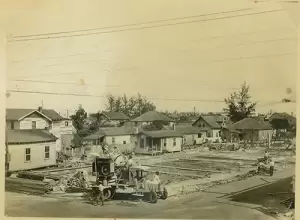
The settlement of African Americans in Palm Beach County was similar to the rest of southeastern Florida. Most blacks first lived on the fringe of white areas, where they found employment. When designated by the white community, black neighborhoods were on less desirable property with barriers to contain them, such as water, highways, or railroad tracks.
In 1929 an ordinance was passed in West Palm Beach to make official the blacks-only section of the city that had been “generally in force under an agreement of many years’ standing.” The Palm Beach Post reported:
The limits of the negro section, from which white residents or businesses would be excluded, extend briefly from the alley north of Clematis Avenue northward to 23rd Street, between the Florida East Coast Railroad tracks and Clear Lake, except that from 17th to 23rd streets, it extends eastward to a point about 150 feet west of Poinsettia Avenue.
These limits, to which the Pleasant City neighborhood was “grandfathered in,” also provided protection against whites taking over blacks’ businesses and were in force until 1960.
During the growth in population and urban areas from the 1920s to the 1940s, blacks became surrounded by white neighborhoods and commercial or industrial areas. In West Palm Beach, overcrowding pushed the blacks north into Riviera Beach along the same corridor between two sets of railroad tracks. Other development prevented black areas from being contiguous.
In 1935 a joint committee of the Delray Beach City Council and a representative committee of the city’s blacks “made a careful investigation” and agreed on Resolution 146, which defined property areas on racial grounds. The “Negro Settlement or Negro Area” was generally west of 3rd Avenue between N.W. 5th Street and S.W. 5th Street.
The limits of the negro section, from which white residents or businesses would be excluded, extend briefly from the alley north of Clematis Avenue northward to 23rd Street, between the Florida East Coast Railroad tracks and Clear Lake, except that from 17th to 23rd streets, it extends eastward to a point about 150 feet west of Poinsettia Avenue.
Palm Beach Post
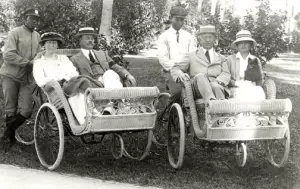
Those blacks that were employed by wealthy Palm Beach whites often enjoyed hand-me-down clothes, extra food, and exposure to culture and travel. They also worked in restaurants, private clubs, and as wheelchair men (afromobiles). In western Palm Beach County, black farm workers had a hard life of labor, though they were generally better off than blacks in many other Florida communities. A 1939 Guide to Florida said of Belle Glade, “A municipal ordinance requires that all Negroes, except those employed within the town, be off the streets by 10:30 p.m. On Saturdays they are permitted to remain in the business district until midnight.” Other towns had similar restrictions.
In the north end of the county, the Limestone Creek community had been settled by African Americans in the late 1800s. Many of the residents, from northern Florida and Georgia, had arrived as railroad employees, but they labored for and with white pioneers to establish the town of Jupiter.
Towns that evolved slowly around farms seemed to adjust to whoever came their way, such as in Boynton Beach, according to Harvey E. Oyer, Jr., in a 2006 oral history interview: “In many ways, yes, there was segregation. … But most of the blacks that did domestic work had white families that they considered like their own. “
The Town of Lake Worth had been established quickly by less racially tolerant people and would not have a school for black children until after World War II. George Greenberg recalled seeing a Ku Klux Klan parade in Lake Worth in the 1920s: “All these men … and their cars were covered with white sheets and it was sort of a scary thing for a young kid to see that. I know my dad said he knew who they were. He recognized them all. Of course, in those days it was a small town, so everybody knew everybody else.”
By the end of the boom and bust era, African Americans in Palm Beach County took steps to improve their future. In 1939 they formed the first local chapter of the National Association for the Advancement of Colored People (NAACP).
Boca Raton’s Pearl City
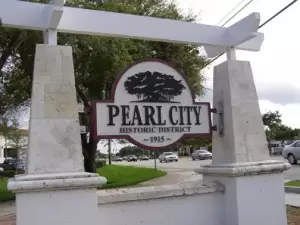
When the first large farm tracts were homesteaded in what would become Boca Raton, their African American laborers walked to work from Deerfield and Delray. As the farms grew, blacks settled nearby.
When Thomas M. Rickards, one of the farmers and Henry Flagler’s land agent in Boca Raton, moved away, he hired George Ashley Long, his successor as Flagler’s agent, to survey and dispose of his land. Long set aside a subdivision for African Americans with three streets: Ruby, Pearl, and Sapphire (N. E. 10th, 11th, and 12th streets) east of Dixie Highway and the Florida East Coast Railway tracks, and west of today’s Federal Highway. Later it became known as Pearl City.
Although many lots were sold at auction in 1915, there were few houses in Pearl City until the late 1920s. “The rest was nothing but woods,” recalled early resident George Spain. Alex Hughes built the first house in the community; he was instrumental in bringing an all-black school and church to Pearl City. Even by 1934, Louise Williams remembered,
[W]here 12th Street is now and Glades Road [was] all bushes and wilderness. It was a sand road, deep sand, and in the summertime you got stuck if you didn’t know how to drive through the sand … [We] didn’t have no running water and we didn’t have no lights. We had outdoor bathrooms, toilets, and we had to take a bath in tin tubs.
Louise Williams
West Palm Beach: Black Residents
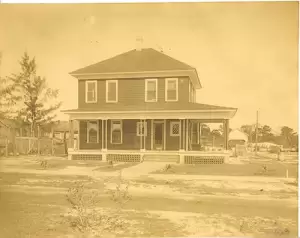
In the 1920s, the most affluent African Americans of West Palm Beach lived in the Freshwater District in houses built by local African American contractors. Hazel Augustus, the city’s first African American architect, designed many of the Freshwater houses, as well as the Payne Chapel AME Church and Tabernacle Baptist Church.
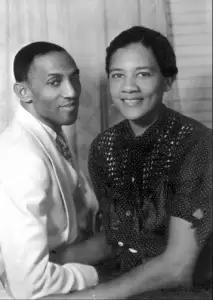
Other black professionals set up business in West Palm Beach. Dr. Thomas LeRoy Jefferson was the first black medical doctor in town, having started in the Styx community of Palm Beach about 1900. Dr. Warren Hale Collie was one of the first black dentists to practice in the county. Collie’s parents, John M. and Amy Warren Collie, brought him to West Palm Beach in 1910. After he finished dental school in 1917, Collie served in France during World War I as a dentist with the 808th Pioneer Infantry. Hazel Augustus later designed the Collie Building for his dental office. Dr. Joseph Wiley Jenkins and his wife, Roberta, opened the Economical Drug Store at 4th Street and Rosemary Avenue in the 1930s. Roberta designed their dream house on Virginia Avenue (now Division Avenue), now the home of the Artists Showcase of the Palm Beaches.

In the 1920s, James Jerome “Cracker” Johnson also built on Division Avenue, at the corner of 14th Street on the highest land in the Northwest neighborhood. He and his wife, Ella, had arrived in West Palm Beach in 1912; both had white fathers and African American mothers.
Johnson owned and operated the Florida Bar on Rosemary Avenue, where employees wore cut-away dinner jackets, tuxedo trousers, winged collared dress shirts with studs and cufflinks, and bow ties. He also owned a rooming house/pool hall on Banyan Street and the Dixie Theater on Rosemary Avenue, ran a party boat, and invested in real estate statewide. Johnson’s businesses, some of them illegal, enabled him to help his community. In 1921, since segregation extended to imprisonment, he provided a red brick jailhouse for blacks at 2nd Street and Rosemary Avenue. Johnson later loaned the city $50,000 to balance its budget and gave jobs to the jobless during the Depression. In 1946 he was shot to death by an unknown assailant behind his Florida Bar.

